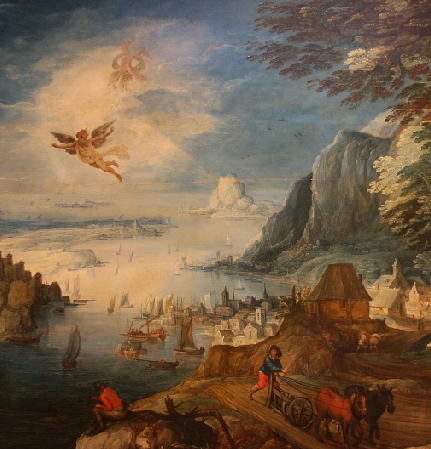Icarus with violinist Hasse Borup and pianist Mary Kathleen Ernst
Instrumentation: Violin and piano
Duration: 15:30
Premiere: 4/8/84
Kevin Lawrence and Juliana Osinchuk
Westmoreland Museum, Greensburg, PA
Program Note:
The myth of Icarus seems an apt metaphor for the creative process: the attempt to transcend, and the riskiness of the endeavor. The story of the escape of Daedalus, noted for his wonderful sculptures, together with his son Icarus is a compelling one. Imprisoned by King Minos in the labyrinth that Daedalus had designed, and the Minotaur later inhabited, Daedalus searched for a means of escape. He fashioned wings made of bird feathers and wax, and he and Icarus flew away, soaring over the Aegean Sea. But, according to the story, Icarus, heedless of his father’s warnings, flew too near the sun, the wax melted and he plunged to a watery grave.
This myth has inspired many artists: Bruegel in his Landscape with the Fall of Icarus; Matisse, in The Flight of Icarus; Auden’s Icarus; William Carlos Williams’s Landscape with the Fall of Icarus; Anne Sexton’s To a Friend Whose Work Has Come to Triumph; Nino Rota’s piano concerto, also named Icarus. There are numerous examples, each with its own twist. My Icarus, composed for violinist Kevin Lawrence in 1983, is cast in four movements. Each was inspired by a different aspect of the story. The first, marked Majestic, is assertive, and confident, with an extended violin cadenza that soars, expressing the will to break barriers, as well as the innocence of one who has not yet had to do so. The second suggests the complex relationships between father and son, now in agreement, now in heated debate. The third hovers in the registral stratosphere, conveying the floating quality of flight, as well as its inevitable turbulence. The last movement shivers with the violence of effort and the catharsis of the plunge. Icarus was recorded by violinist Hasse Borup and pianist Mary Kathleen Ernst on Tower of the Eight Winds, a CD of Shatin’s violin/piano music on Innova.–JS
Press Quote:
In the movement titled “Majestic” in Shatin’s Icarus, a beautiful violin solo with double stops takes your breath away. We can sense the hubris of Icarus in the music as the father-son relationship is translated into a rhythmic and harmonic dialogue between violin and piano. The piano reflects sobriety as the violin expresses youthful enthusiasm. Borup excels here with gorgeous playing in the upper range. In “Delirious,” Icarus’s second movement, we soon become aware that Shatin creates basically tonal and accessible music as the piano commences a kind of a rag, which seems to me to reflect Icarus and his dad taking turns losing their respective cools. “Soaring” begins with sustained harmonics and rolled chords. The piano seems grounded while the violin soars, and in “Wild”—well, we all know how the story ends. This is a film made up of musical phrases instead of scenes. –David Wolman, Fanfare

